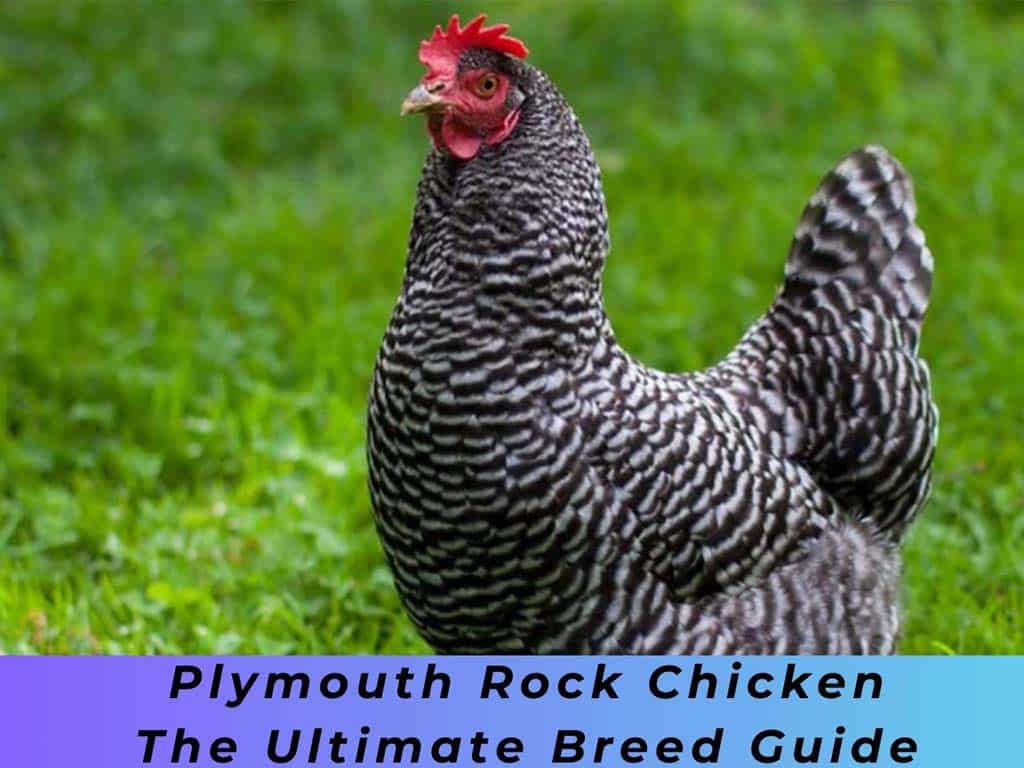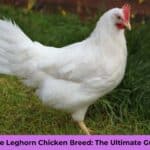Are you considering adding some feathered friends to your backyard flock? Look no further than the Plymouth Barred Rock chicken breed.
These striking birds, with their distinctive black and white striped feathers, have been a favorite among poultry enthusiasts for over a century.
In this comprehensive guide, we’ll explore everything you need to know about these remarkable chickens, from their rich history to their care requirements.
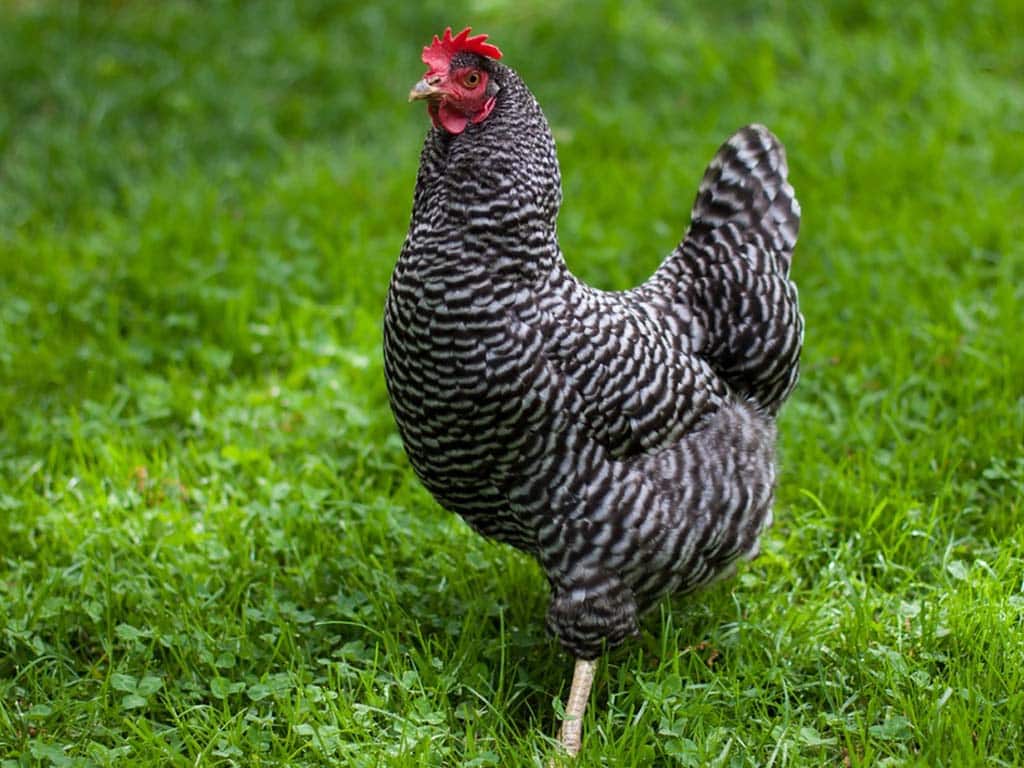
The Roots of the Rock: Tracing Plymouth Rock Chicken History
The Plymouth Barred Rock chicken breed boasts a fascinating history that’s deeply intertwined with America’s agricultural heritage. Developed in the mid-19th century in Massachusetts, these birds quickly gained popularity for their dual-purpose nature and striking appearance.
Birth of a Barnyard Star: When and Where Plymouth Rock Chickens Began
The exact origin of the Barred Rock is somewhat shrouded in mystery, but most accounts agree that they were developed by crossing Dominique and Black Java chickens. This clever combination resulted in a bird that inherited the hardy nature of the Dominique and the size of the Black Java.
“The Plymouth Rock is the bird for the farmer and fancier.” – D.A. Upham, one of the breed’s early developers
From Farmyard to Fame: The Plymouth Rock Chicken’s Rise to Popularity
The Barred Rock made its debut at America’s first poultry show in Boston in 1849, where it quickly caught the eye of both farmers and poultry enthusiasts. By 1874, the breed had gained official recognition from the American Poultry Association, cementing its status as a standard breed.
Plymouth Rock Chickens vs. Barred Rocks: Cracking the Confusion
It’s worth noting that while all Barred Rocks are Plymouth Rocks, not all Plymouth Rocks are Barred. The Plymouth Rock breed includes several color varieties, with the Barred pattern being the most well-known and popular.
| Plymouth Rock Varieties |
| Barred |
| White |
| Buff |
| Partridge |
| Silver Penciled |
| Blue |
| Columbian |
Check this out Are Penguins Friendly Or Are Penguins Dangerous?
Strutting Their Stuff: Plymouth Rock Chicken Appearance and Characteristics
The Barred Rock chicken is a sight to behold, with its distinctive plumage and robust build. Let’s take a closer look at what makes these birds stand out in the coop.
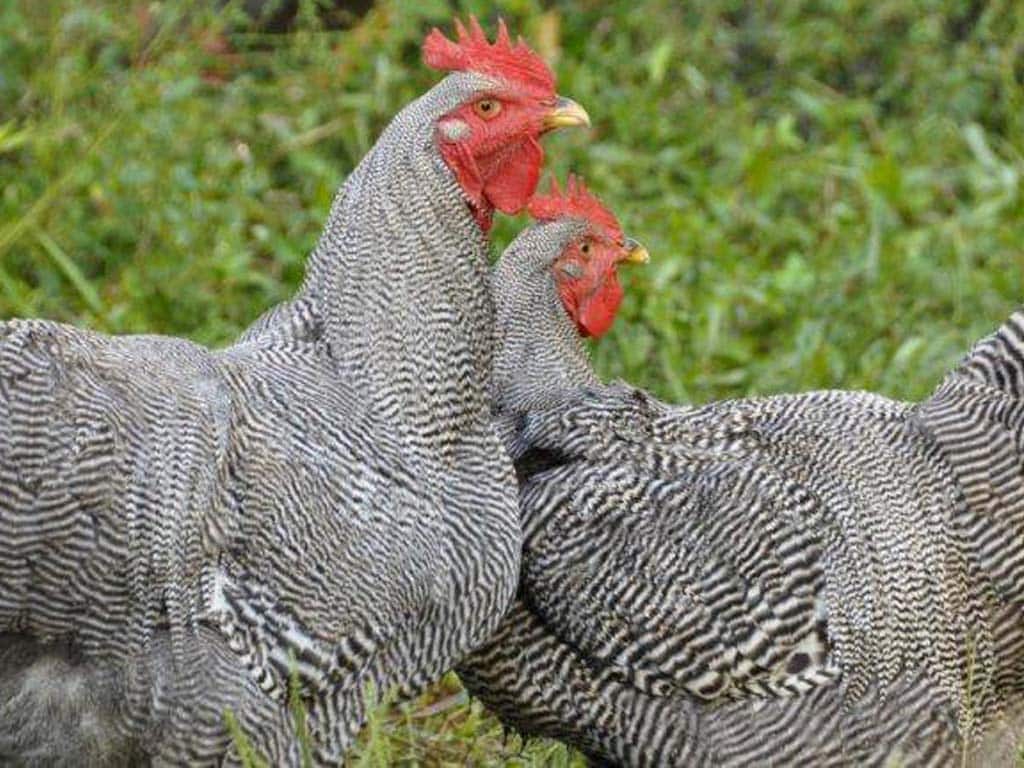
Feather Fashion: The Iconic Plymouth Rock Chicken Pattern
The most striking feature of the Barred Rock is its barred feathers. Each feather displays alternating bands of black and white, creating a mesmerizing striped effect across the bird’s entire body. This pattern, also known as cuckoo, is not only beautiful but also serves a practical purpose by providing camouflage in natural settings.
Size Matters: Weight Ranges for Plymouth Rock Roosters and Hens
Barred Rocks are medium to large birds with a broad, deep body and full breast. They have a rectangular shape when viewed from the side, giving them a sturdy and well-balanced appearance.
- Roosters typically weigh around 9.5 pounds
- Hens average about 7.5 pounds
Head Features
The head of a Barred Rock is adorned with several notable features:
- Comb: Single, medium-sized, and bright red. In roosters, it stands upright, while in hens, it may flop slightly to one side.
- Wattles: Medium to large and bright red
- Earlobes: Bright red
- Beak: Strong and yellow
Legs and Feet
Barred Rocks have clean, yellow legs with four toes on each foot. Their strong legs make them excellent foragers and allow them to handle various terrain with ease.
Personality Plus: Temperament and Behavior
One of the reasons Barred Rock chickens have remained popular for so long is their wonderful temperament. These birds are known for their docile and friendly nature, making them an excellent choice for families and first-time chicken keepers.
Friendly and Curious
Barred Rocks are often described as:
- Gentle
- Inquisitive
- People-oriented
Many owners report that their Barred Rocks will follow them around the yard, eager to see what their human caretakers are up to. This friendly demeanor makes them great pets, especially for families with children.
Flock Dynamics
Within the flock, Barred Rocks tend to be:
- Calm: They rarely start fights with other chickens
- Assertive: While not aggressive, they can hold their own in the pecking order
- Adaptable: They integrate well into existing flocks
“My Barred Rocks are like the peacekeepers of the coop. They get along with everyone but don’t let themselves get pushed around.” – Sarah, backyard chicken enthusiast
Check this out Why Do Crows Chase Hawks? Do Crows Hate Hawks?
Noise Levels: Will Your Plymouth Rock Chickens Make the Neighbors Complain?
While not the quietest breed, Barred Rocks are generally considered moderate in terms of noise. Hens will cluck contentedly throughout the day and may announce egg-laying with a celebratory song. Roosters, as with most breeds, will crow, especially in the morning.
Note: If you live in an urban area with strict noise regulations, you may want to consider keeping only hens or choosing a quieter breed.
Egg-cellent Producers: The Plymouth Rock Chicken Laying Lowdown
One of the primary reasons for the enduring popularity of Barred Rock chickens is their impressive egg-laying capabilities. As a dual-purpose breed, they’re prized for both their meat and egg production, but it’s their consistent laying that often steals the show.
Egg Color and Size: What to Expect from Your Plymouth Rock Hens
- Color: Brown eggs, ranging from light to medium brown
- Size: Large to extra-large
- Texture: Smooth-shelled
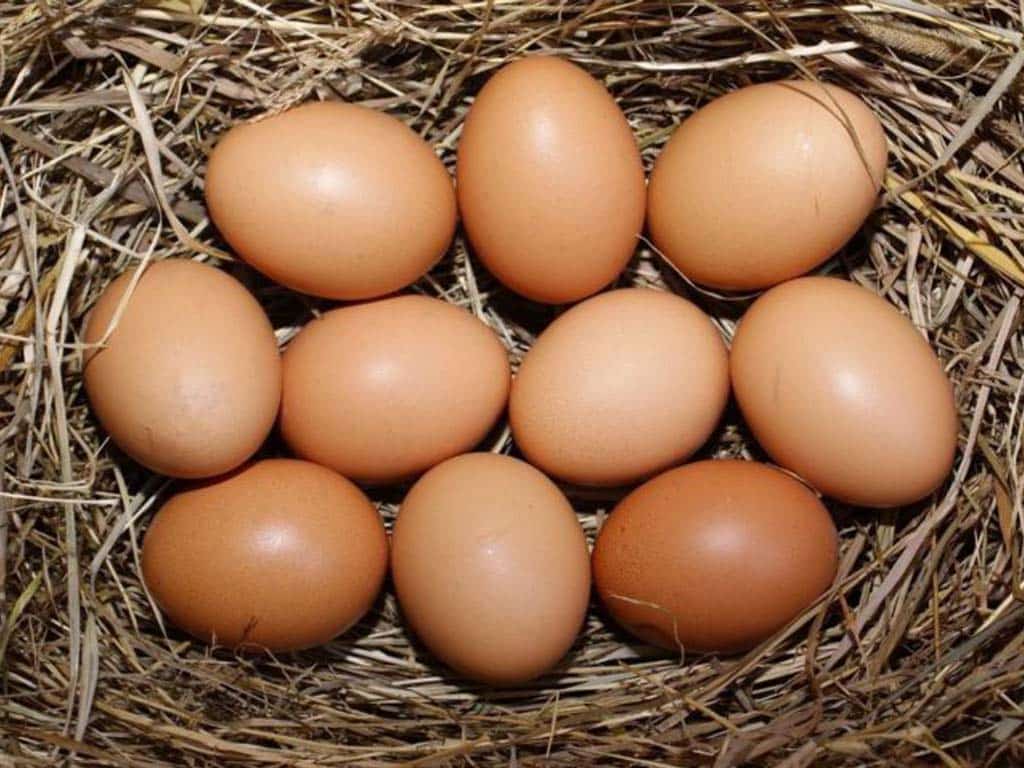
Production Numbers: How Many Eggs Can You Count On from Plymouth Rock Chickens?
On average, a healthy Barred Rock hen can lay:
- 4 eggs per week
- 200-280 eggs per year
This puts them in the top tier of egg-producing breeds, rivaling some of the best layers like Rhode Island Reds and Leghorns.
Factors Affecting Egg Production
Several factors can influence how many eggs your Barred Rocks will lay:
- Age: Hens start laying around 18-20 weeks old and are most productive in their first two years.
- Diet: A balanced diet rich in protein and calcium is crucial for optimal egg production.
- Daylight: Hens need about 14-16 hours of light per day to maintain peak laying.
- Health: Any illness or stress can significantly reduce egg production.
- Season: Many hens slow down or stop laying during winter months when daylight is scarce.
Broodiness
Broodiness, or the tendency to sit on eggs to hatch them, is moderate in Barred Rocks. While not as prone to broodiness as some heritage breeds, some hens may occasionally go broody. This can be a plus if you’re interested in hatching chicks naturally, but it can also interrupt egg production.
Check this out 24 Yellow Birds In Ohio With Photos
Tough as Clucks: Plymouth Rock Chicken Health and Hardiness
Barred Rock chickens are renowned for their robustness and ability to thrive in various environments. This hardiness is one of the key reasons they’ve remained a favorite among backyard chicken keepers and small-scale farmers alike.
Cold Weather Warriors: The Impressive Resilience of Plymouth Rock Chickens
These birds showcase impressive adaptability to different climates:
- Cold Hardiness: Excellent. Their dense feathering and sturdy build make them well-suited to cold winters.
- Heat Tolerance: Good, but not exceptional. They can manage in warm climates but may need extra care during extreme heat.
Disease Resistance
While generally healthy, Barred Rocks can be susceptible to common chicken ailments. Here’s a quick rundown of health issues to watch for:
| Health Issue | Description | Prevention |
| Marek’s Disease | Viral infection affecting nervous system | Vaccination at hatchery |
| Coccidiosis | Intestinal parasites | Clean coop, medicated feed for chicks |
| Egg Binding | Egg stuck in oviduct | Proper nutrition, adequate calcium |
| Bumblefoot | Staph infection in foot | Clean coop, regular foot checks |
Lifespan
With proper care, Barred Rock chickens typically live:
- 6 to 8 years on average
- Up to 10-12 years in optimal conditions
Factors influencing lifespan include genetics, diet, environment, and overall care.
Home Sweet Home: Housing Requirements
Providing appropriate housing is crucial for the health and happiness of your Barred Rock chickens. While they’re adaptable birds, they do have specific needs to thrive.
Check this out How and Where Do Geese Sleep? The Secrets of Goose Slumber
Space Requirements
Barred Rocks are medium to large birds and need adequate space to prevent stress and maintain good health.
- Coop Space: 4-5 square feet per bird
- Run Space: 10-15 square feet per bird (more if possible)
Coop Features
A well-designed coop for Barred Rocks should include:
- Ventilation: Good airflow while avoiding drafts
- Roosts: 8-10 inches of roost space per bird, positioned higher than nesting boxes
- Nesting Boxes: One box per 3-4 hens, filled with clean bedding
- Predator Protection: Secure locks and predator-proof construction
- Insulation: For colder climates, to maintain warmth in winter
Free-Range Options
Barred Rocks are excellent foragers and do well in free-range or pasture-based systems. If you have the space, allowing them to roam will:
- Supplement their diet with insects and plants
- Provide exercise and mental stimulation
- Potentially improve egg quality
“My Barred Rocks are happiest when they’re out exploring the yard. They’re like little dinosaurs, always on the hunt for the next tasty bug!” – Mark, hobby farmer
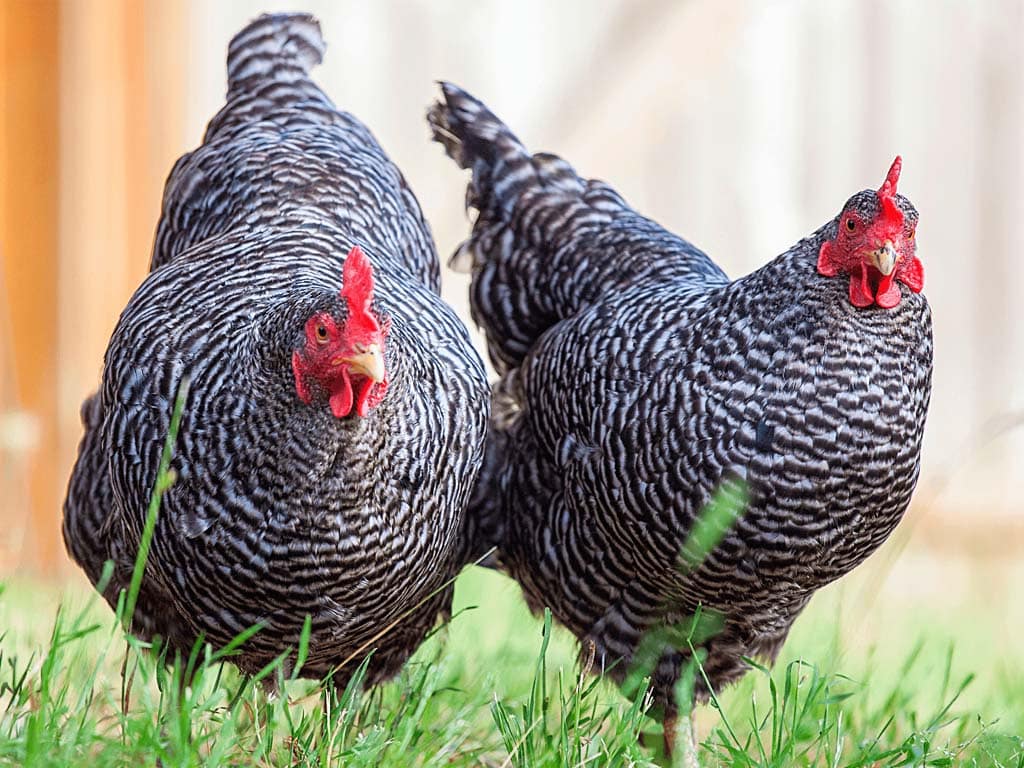
Feeding for Success: Nutritional Needs
Proper nutrition is key to keeping your Barred Rock chickens healthy, productive, and happy. As a dual-purpose breed, their dietary needs balance egg production and body maintenance.
Basic Diet
A high-quality commercial layer feed should form the foundation of your Barred Rocks’ diet. Look for a feed that provides:
- 16-18% protein for laying hens
- 20-22% protein for growing chicks and molting adults
Supplemental Foods
To keep your chickens healthy and their diet varied, consider offering these supplements:
- Grit: Essential for digestion, especially if feeding whole grains
- Oyster Shell: Provides extra calcium for strong eggshells
- Kitchen Scraps: Fruits and vegetables as treats (avoid avocado, chocolate, and anything moldy)
- Herbs: Fresh herbs like oregano, thyme, and mint can boost immunity
Foraging
If allowed to free-range, Barred Rocks will supplement their diet with:
- Insects and worms
- Seeds and grasses
- Small pebbles (natural grit)
Water
Clean, fresh water should be available at all times. In winter, consider using a heated waterer to prevent freezing.
Check this out Finches In Florida – The Complete Guide To Florida Finches
Breeding Barred Rocks: Genetics and Considerations
Breeding Barred Rock chickens can be a rewarding experience, whether you’re looking to expand your flock or improve certain traits. Understanding the genetics behind their distinctive appearance is key to successful breeding.
Barred Feather Pattern Inheritance
The barred pattern is sex-linked, which means:
- Males need only one copy of the barring gene to show the pattern
- Females need two copies to show the pattern
This leads to some interesting breeding outcomes:
- Barred Rock rooster × Barred Rock hen:
- All offspring will be barred
- Males and females can be distinguished at hatch (males are lighter)
- Barred Rock rooster × solid color hen:
- All male offspring will be barred
- All female offspring will be the color of the mother
Breeding Goals
When breeding Barred Rocks, consider these traits:
- Size and Shape: Aim for birds that meet the breed standard
- Egg Production: Select hens with high lay rates
- Temperament: Choose calm, friendly birds for breeding
- Health: Only breed from robust, disease-free stock
Incubation and Hatching
If you’re incubating Barred Rock eggs:
- Incubation period: 21 days
- Temperature: 99.5°F (37.5°C)
- Humidity: 50-55% for first 18 days, 65% for last 3 days
Barred Rocks in the Show Ring
While primarily valued for their practical qualities, Barred Rock chickens also have a place in poultry exhibitions. Their striking appearance and historical significance make them popular show birds.
American Poultry Association Standards
The APA standards for Barred Plymouth Rocks include:
- Weight: Cock 9.5 lbs, Hen 7.5 lbs
- Comb: Single, medium size, bright red
- Eyes: Reddish bay
- Beak: Yellow
- Shanks and Toes: Yellow, free from feathers
Preparing for Shows
To get your Barred Rocks ready for exhibition:
- Bathing: Gently wash the bird 2-3 days before the show
- Grooming: Trim nails and beak if necessary
- Conditioning: Ensure the bird is in peak health and weight
- Training: Familiarize your bird with handling to reduce stress during judging
Barred Rocks vs. Similar Breeds
While Barred Rock chickens are unique, they share some characteristics with other breeds. Here’s how they compare:
| Breed | Egg Production | Size | Temperament | Cold Hardiness |
| Barred Rock | 200-280/year | Large | Docile | Excellent |
| Cuckoo Marans | 150-200/year | Large | Calm | Good |
| Dominique | 230-275/year | Medium | Docile | Excellent |
| Columbian Wyandotte | 200-240/year | Medium | Friendly | Very Good |
Conclusion: Is the Barred Rock Right for You?
Barred Rock chickens offer a wonderful combination of productivity, hardiness, and friendly temperament. They’re an excellent choice for:
- Beginners looking for an easy-to-care-for breed
- Families wanting friendly backyard chickens
- Small-scale farmers seeking a dual-purpose breed
- Those interested in preserving heritage breeds
However, they may not be ideal if:
- You live in an area with strict noise regulations (due to their moderate noise levels)
- You’re looking for a breed that lays colored eggs (like blue or green)
Ultimately, the decision comes down to your specific needs and circumstances. But for many chicken keepers, the Barred Rock has proven to be a reliable, rewarding choice that combines the best of both worlds – a productive farm animal and a charming backyard pet.

